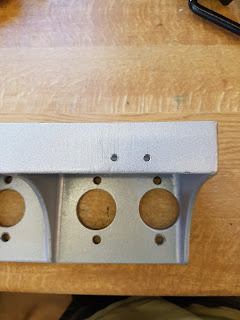I started by removing the mounting flanges from the ends by partially drilling the spot welds and then chiselling them off. I then used a flap wheel on the grinder to polish down the surface before coating it with satin black paint. In hindsight, you probably only need to cut remove the N/S flange since there is room for it on the inner side.
I then used previous blogs to calculate where to mount the rivnuts. I placed the top ones in line with the top screws for the extract pipes, and 30mm in from the edge. I then drilled the bottom ones 8mm up from the bottom so that the rivnut clears the heater matrix. Just ensure you use the correct length of set screw to prevent puncturing the heater matrix!
Once I drilled the 9mm hole to take the M6 rivnut, I found that the rivnuts I have don't like the 1mm thickness of the heater! The rivnut couldn't grip. This was only for the top ones, since the bottom ones were located through a double skinned part.
I decided, that the only thing to do was to drill out the attempted nut and fit a coupled more rivnuts, with a stainless plate in between the two to prevent them from spinning. So I drilled another 2x 9mm holes in line with the bottom screws and 30mm in from the sides. I then made a small plate linking the 2 from 1.5mm stainless so that the rivnut could grip properly.
A bit of extra work, but at least they now grip! There may have been an easier method, but it's all I thought I could do with what I had in the garage...... There are some scuff marks on the newly painted sides due to the number of trial fits! I had my daughter helping to screw in the set screws while I held the unit from the wheel arch.... (also in this photo you can see the 60mm hole cut for the ECU wiring loom.)
I then made a template from card marking the holes to be drilled along with the discharge pipes. The heater assembly (minus motor and matrix) was then placed inside the N/S compartment and held up to the bulkhead and the rectangular hole was marked through to line up the holes. I found that by keeping the bottom of the heater box inline with the top of the side vent was roughly the correct height.
I then drilled through the mount holes and discharge pipe holes. I have just used the top and bottom rivnuts and 25mm long M6 set screws.
Then by leaving the matrix out and the side off the heater box, I could transfer the position to the engine bay. I then used the side plate with the 2 cutouts to locate the hose position. I then removed the heater box, drilled a 3mm hole through from the inside and drilled the 25mm hole through from the engine bay to align for the hose. I could then measure and drill for the 2nd hose which is a 90 degree elbow fitted to the rearmost connection.
While I was at it, I drilled the 44mm hole for the wiring loom, and the 2x 10mm holes for the battery connectors.
I also require a short piece of 16mm pipe to join the silicon hose as seen above to another 90 degree elbow to connect to the fixed pipe on the chassis.



















